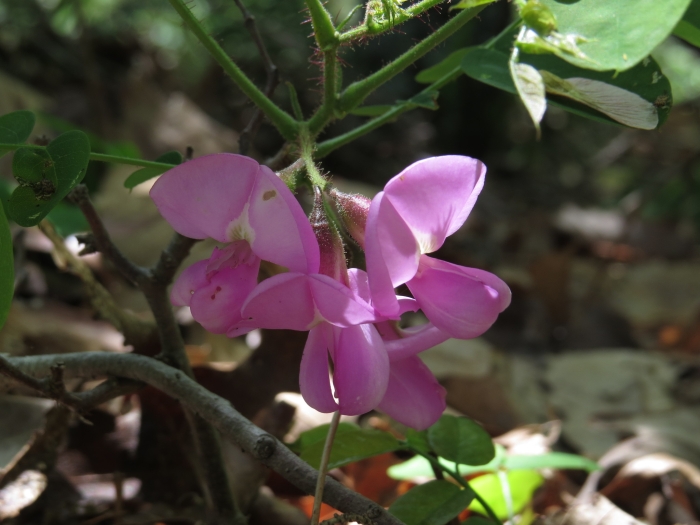Bristly Locust
(Robinia hispida)
Bristly Locust (Robinia hispida)
/
/

Evan M. Raskin
CC BY 4.0
Image By:
Evan M. Raskin
Recorded By:
Copyright:
CC BY 4.0
Copyright Notice:
Photo by: Evan M. Raskin | License Type: CC BY 4.0 | License URL: http://creativecommons.org/licenses/by/4.0/ | Rights Holder: Evan M. Raskin | Publisher: iNaturalist | Date Created: 2017-04-28T14:20:44-07:00 |



















































Estimated Native Range
Summary
Robinia hispida, commonly known as Bristly Locust, is a deciduous shrub native to the southeastern United States, particularly found in the Appalachian Mountains. It typically grows to a height of 2-10 feet (0.6-3 meters) and a width of 5-15 feet (1.5-4.6 meters). This species thrives in a variety of habitats, including open woodlands, forest edges, and rocky slopes. It is notable for its bristly stems and striking flowers.
Bristly Locust is appreciated for its ornamental value, particularly its showy clusters of pea-like flowers that bloom in late spring to early summer. The flowers range in color from pink to purple and red, and they attract pollinators such as bees and butterflies. The plant is used in cultivation for erosion control due to its fast growth and spreading habit, making it suitable for naturalizing in wild areas or for use in restoration projects. It requires full sun to part shade and is adaptable to various soil types, though it prefers well-drained soils. While it is drought-tolerant once established, it benefits from occasional watering during prolonged dry periods. Bristly Locust can spread aggressively by suckers, which may be a concern in garden settings. It is also susceptible to locust borer and can be affected by leaf miners and caterpillars.CC BY-SA 4.0
Bristly Locust is appreciated for its ornamental value, particularly its showy clusters of pea-like flowers that bloom in late spring to early summer. The flowers range in color from pink to purple and red, and they attract pollinators such as bees and butterflies. The plant is used in cultivation for erosion control due to its fast growth and spreading habit, making it suitable for naturalizing in wild areas or for use in restoration projects. It requires full sun to part shade and is adaptable to various soil types, though it prefers well-drained soils. While it is drought-tolerant once established, it benefits from occasional watering during prolonged dry periods. Bristly Locust can spread aggressively by suckers, which may be a concern in garden settings. It is also susceptible to locust borer and can be affected by leaf miners and caterpillars.CC BY-SA 4.0
Plant Description
- Plant Type: Tree, Shrub
- Height: 2-10 feet
- Width: 5-15 feet
- Growth Rate: Rapid
- Flower Color: Pink
- Flowering Season: Spring
- Leaf Retention: Deciduous
Growth Requirements
- Sun: Full Sun, Part Shade
- Water: Low, Medium
- Drainage: Medium
Common Uses
Bank Stabilization, Bee Garden, Bird Garden, Deer Resistant, Drought Tolerant, Erosion Control, Salt Tolerant, Showy Flowers
Natural Habitat
Native to the southeastern United States, particularly in the Appalachian Mountains and forest edges
Other Names
Common Names: Rose Locust, Moss Locust, Rose-Acacia, Acacia Rose, Robinier Hispide, Akatziya Rozovaya, Robiniya Shchetinistovolosaya, 꽃아카시나무
Scientific Names: , Robinia hispida, Robinia grandiflora, Robinia kelseyi, Pseudo-acacia hispida, Robinia hispida var. boyntonii, Robinia hispida var. typica, Robinia rosea,
GBIF Accepted Name: Robinia hispida L.